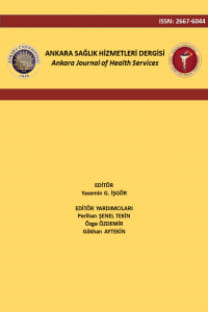İleri Evre Küçük Hücreli Dışı Akciğer Kanserinde Palyatif Amaçlı Tek Doz 10 Gy Tedavi Şemasının Etkinliği
Küçük hücreli dışı, akciğer kanseri, palyasyon
The Effectivenes of Single Fraction 10 Gy Treatment Planning in Patients with Advanced Non-Small Cell Lung Cancer
Non-small cell, lung cancer, palliation,
___
- Chay TK: Role of radiotherapy in advanced carcinoma of the lung. Proceedins 7th Asia-Pasific Congres on Diseases of the Chinese, Nandi PL , Lam WK (Eds) Hong Kong, Southeast Printing Co 1981, pp. 300-304
- Perez CA , Stanley K , Grandy G. et al: Impact of irradiation technique and tumor extent in tumor control and survival of patients with unresectable non-oat cell carcinoma of the lung: Report by the Radiation Therapy Oncology Group. Cancer 1989; 1091-1099
- Carroll M , Morgan SA, Yarnold. et all. Prospective evaluation of a watch policy in patients with inoperabl non–small-cell lung cancer. Eur J. Cancer Clin. Oncol, 22, 1353-1356
- Fowler JF. : Non-standard fractionation in radiotherapy. Int. J. Radiat. Oncol. Biol Phys. 1984; 10(5) : 755-759
- Moore J: Recent advances in radiobiology. In Modern Trends in Radiotherapy, vol.2, Deeley TJ. (Ed.).London, Betherworths. 1972, pp 21-25
- Overgoard M: The clinical implications of non-standard fractionation (Letter). Int J. Radiat. Oncol. Biol. Phys. 1985; 11(6): 1225-1227
- Peschel RE, Fisher JJ. : Optimization of the time–dose relationship, Sem. Oncol. 1981; 8 (1): 38-48
- Withers HR : Biologic basis for altered fractionation scheme. Cancer 1985; 55 (Suppl,9):2086-2095
- Peter Teo TH, Tai Domon Cho et al: A randomized study on palliative radiation therapy for inoperable non small cell carcinoma of lung . Int J Radiation Oncology Biol. Phys: 1987; 14: 867-870
- Lung Cancer Working Party: In operable non small cell lung cancer: A Medical Research Council randomize trial of palliative radiotherapy with two fraction or ten fraction.
- Lung Cancer Working Party, MRC randomize trial of palliative radiotherapy with two fraction or single fraction in patient with inoperable non small cell lung cancer and poor performance status. Br J. Cancer 1992; 65: 934-941
- Yayın Aralığı: Yılda 2 Sayı
- Başlangıç: 2000
- Yayıncı: Ankara Üniversitesi
Ulukavak ÇİFTÇİ TANSU, Yıldız GÜNEY, Ayşe BİLGEHAN, Filiz ÇİMEN
Yıldız GÜNEY, Ayşe BİLGİHAN, Ulukavak ÇİFTÇİ TANSU, Filiz ÇİMEN, Özgür COŞKUN
S İNAN, T ÖZGÜDER, H.S. VATANSEVER, K ÖZBİLGİN, M. SANCI, S. SAYHAN
Endometriyal Hiperplazilerin Tedavisinde Vajinal Progestoron Jelin Etkinliği
Bülbül BAYTUR YEŞİM, Semra ORUÇ, Barış ÇOBAN, Fatma ESKİCİOĞLU, Rıza KANDİLOĞLU Ali
Epidermoid Baş-Boyun Kanserlerinin Tedavisinde Hiperfraksiyone Radyoterapi Sonuçları
Ayşe HİÇSÖNMEZ, Yıldız GÜNEY, Ayşen DİZMAN, Nalça ANDRIEU MELTEM
Postoperatif Ağrıda Transdermal Fentanil Kullanımı
Normal ve Sezeyan Doğumlarda Maternal ve Umbinikal Kordon Karnında Endotelin-1 Düzeyleri
BÜLBÜL BAYTUR Yeşim, Cevval ULMAN, Göker TAMA Aslı, Ahmet VAR, Hüsnü ÇAĞLAR
